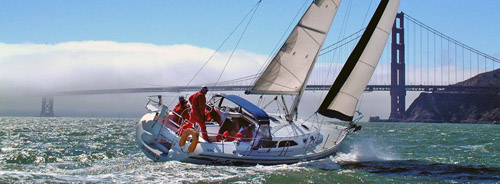Boats are like children. Not in what they are, but in what they do. They both are here on earth mainly to remind us—the adults and, ostensibly, the people in charge—that we are not the center of the universe.

Surrendering yourself to the sailing experience and making your vessel the center of your universe is the only way to sail well.
By Scott Alumbaugh
Published: November, 2007
Boats are like children. Not in what they are, but in what they do. They both are here on earth mainly to remind us—the adults and, ostensibly, the people in charge—that we are not the center of the universe.
Now, we all know, intellectually, that we are not the most important things or people in the universe. But we often act as if we were. Once you have a child, though, your entire orientation toward life changes. Your needs are subjugated, willingly or by force, to your newborn. And it only gets worse from there.
The same is true with sailing. Once you step on board a boat, your orientation changes. It’s not as apparent as when you have a child. There is no messy diaper to change to remind you that it is no longer all about you. But make no mistake. You are no longer the center of things; the vessel is. So the bow is not in front of you, nor the stern behind; they are forward and aft, no matter which way you face. As you sail out of Berkeley Marina, the Richmond-San Rafael Bridge is not to your right, nor is the Oakland-San Francisco Bay Bridge to your left; they are to starboard and port, respectively.
To most new sailors, these distinctions often seem either arcane or obnoxious. But they are important. Clear communication is essential to sailing, because when things go wrong on the water, they tend to do so in a hurry. Clarity and precision in terminology can really become a matter of life and death at sea.
Up until the 1840s, for instance, the terms for lateral direction on a sailing vessel were starboard and larboard. Starboard is an archaic term, derived from the fact that the steering board on ancient vessels was on the right-hand side of the boat, as you face forward. The other side was the side that was tied to the dock, and on which cargo was loaded on board. In the 1840s, both the U.S. and British navies finally figured out that in a howling storm it might be hard to distinguish between larboard and starboard, and decreed that the left side of the boat, facing forward, would from then on be referred to as port.
It often turns out also that the way new sailors adapt to using sailing terminology can tell you a lot about how well they are going to handle a boat. The reason is that a lot of sailing is about giving up control. You don’t harness the wind, as if it were a horse, and bend it to your will. A good sailor does not steer a sailboat with a rudder, but does so mostly by trimming the sails to the wind’s direction and strength. Probably the hardest thing to learn about sailing a boat is that the boat knows how to sail better than any of us. And the more you can relinquish your desire to control the boat—the easier it is for you to step aside and let the boat be the center of your universe—the better the boat will sail.
Those who chafe at having to learn the difference between amidships and athwartships are the ones who learn that lesson the hard way. You can sail poorly in most places are get away with it because the winds are light. But not in the strong winds of San Francisco Bay. A good broach in a stiff breeze, where the boat suddenly heaves over and spins upwind opposite from the direction you were steering, tells you all you need to know about who or what is in control. In that sense, it’s the kinetic equivalent of a poopy diaper. Like having a child, you now know who’s boss.
And it only gets better from there.
Scott Alumbaugh

